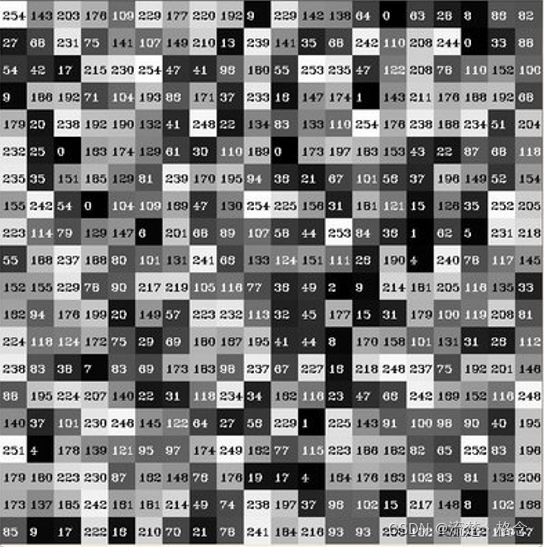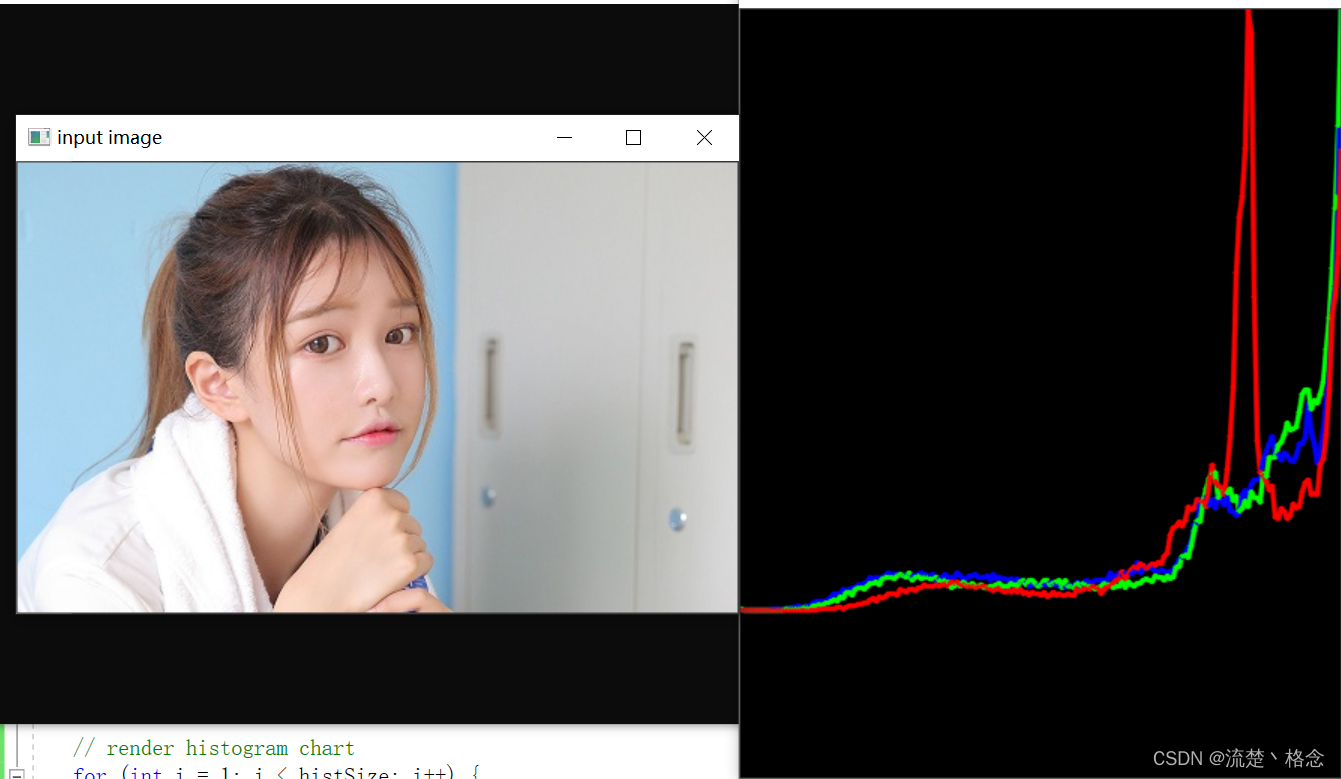直方图计算介绍
直方图均值化概念
可以参考我的另一篇博文:https://yangyongli.blog.csdn.net/article/details/122663041
直方图计算

例如将上面图像像素值建如下直方图:

上述直方图概念是基于图像像素值,其实对图像梯度、每个像素的角度、等一切图像的属性值,我们都可以建立直方图。这个才是直方图的概念真正意义,不过是基于图像像素灰度直方图是最常见的。
直方图最常见的几个属性:
dims表示维度,对灰度图像来说只有一个通道值dims=1bins表示在维度中子区域大小划分,bins=256,划分为256个级别range表示值得范围,灰度值范围为[0~255]之间
相关API
split
函数作用:把多通道图像分为多个单通道图像
函数原型:
split(
const Mat &src, // 输入图像
Mat* mvbegin // 输出的通道图像数组
)
minMaxLoc
函数作用:寻找最值函数
函数原型:
void minMaxLoc(
InputArray src,
double* minVal,
double* maxVal=0,
Point* minLoc=0,
Point* maxLoc=0,
InputArray mask=noArray()
)
函数参数:
src:输入单通道阵列minVal:返回最小值的指针,若无需返回,此值置为NULLmaxVal:返回最大值的指针,若无需返回,此值置为NULLminLoc:返回最小位置的指针(二维情况下),若无需返回,此值置为NULLmaxLoc:返回最大位置的指针(二维情况下),若无需返回,此值置为NULLmask:用于选择子阵列的可选掩膜
calcHist
函数作用:用来计算图像直方图的
函数原型:
calcHist(
const Mat* images, // 输入图像指针
int images, // 图像数目
const int* channels,// 通道数
InputArray mask, // 输入mask,可选,不用
OutputArray hist, // 输出的直方图数据
int dims, // 维数
const int* histsize,// 直方图级数
const float* ranges,// 值域范围
bool uniform, // true by default
bool accumulate // false by defaut
)
代码示例

#include <iostream>
#include <math.h>
#include <opencv2/opencv.hpp>
#include <opencv2/highgui.hpp>
#include <opencv2/highgui/highgui_c.h>
using namespace std;
using namespace cv;
int main(int argc, char** argv)
{
// 图像加载
Mat src = imread("./test2.jpg");
if (!src.data) {
printf("could not load image...\n");
return -1;
}
char INPUT_T[] = "input image";
char OUTPUT_T[] = "histogram demo";
namedWindow(INPUT_T, CV_WINDOW_AUTOSIZE);
namedWindow(OUTPUT_T, CV_WINDOW_AUTOSIZE);
imshow(INPUT_T, src);
// 分通道显示
vector<Mat> bgr_planes;
split(src, bgr_planes);
//imshow("single channel demo", bgr_planes[0]);
// 计算直方图
int histSize = 256;
float range[] = { 0, 256 };
const float *histRanges = { range };
Mat b_hist, g_hist, r_hist;
calcHist(&bgr_planes[0], 1, 0, Mat(), b_hist, 1, &histSize, &histRanges, true, false);
calcHist(&bgr_planes[1], 1, 0, Mat(), g_hist, 1, &histSize, &histRanges, true, false);
calcHist(&bgr_planes[2], 1, 0, Mat(), r_hist, 1, &histSize, &histRanges, true, false);
// 归一化
int hist_h = 400; // 直方图图像高
int hist_w = 512; // 直方图图像宽
int bin_w = hist_w / histSize;
Mat histImage(hist_w, hist_h, CV_8UC3, Scalar(0, 0, 0));
normalize(b_hist, b_hist, 0, hist_h, NORM_MINMAX, -1, Mat());
normalize(g_hist, g_hist, 0, hist_h, NORM_MINMAX, -1, Mat());
normalize(r_hist, r_hist, 0, hist_h, NORM_MINMAX, -1, Mat());
// render histogram chart
for (int i = 1; i < histSize; i++) {
line(histImage, Point((i - 1)*bin_w, hist_h - cvRound(b_hist.at<float>(i - 1))),
Point((i)*bin_w, hist_h - cvRound(b_hist.at<float>(i))), Scalar(255, 0, 0), 2, LINE_AA);
line(histImage, Point((i - 1)*bin_w, hist_h - cvRound(g_hist.at<float>(i - 1))),
Point((i)*bin_w, hist_h - cvRound(g_hist.at<float>(i))), Scalar(0, 255, 0), 2, LINE_AA);
line(histImage, Point((i - 1)*bin_w, hist_h - cvRound(r_hist.at<float>(i - 1))),
Point((i)*bin_w, hist_h - cvRound(r_hist.at<float>(i))), Scalar(0, 0, 255), 2, LINE_AA);
}
imshow(OUTPUT_T, histImage);
waitKey(0);
return 0;
}